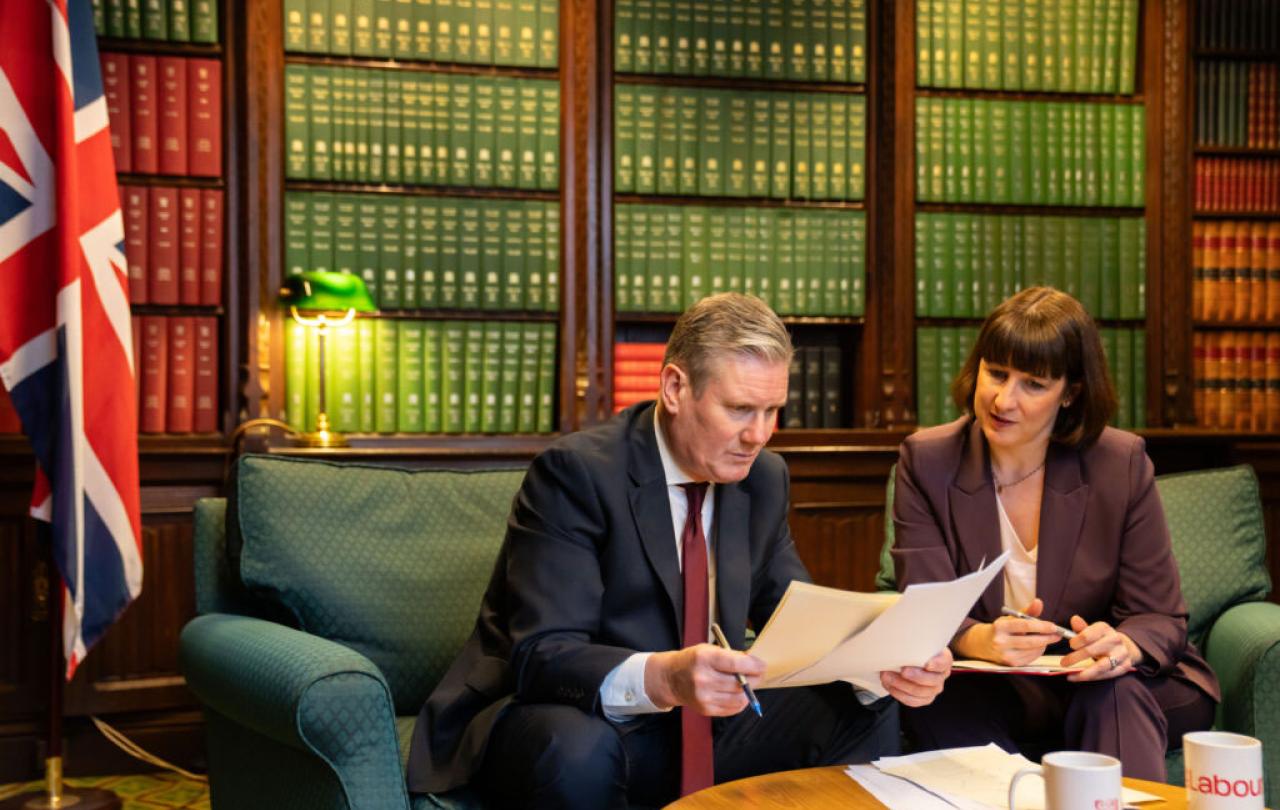
In the aftermath of a historic election, one could do worse than read Will Hutton’s second big ‘state of the nation book’, recently published. This Time No Mistakes is worth reading just for the succinctness and clarity of its politic-economic history of the United Kingdom since the industrial revolution, which it provides in its central chapters. Indeed, Keir Starmer says it is a ‘brilliant book... read it if you haven't already’ It may well take a sophisticated journalist to be able to do this so well: too often, even the best of academics cannot see the public wood for their private-obsessional trees.
But it is doubly and mainly worth reading for Hutton’s prognosis of our ills and his recommendations for solving them. The new Labour government could do far worse than try to carry through Hutton’s proposals, which almost anyone of common sense and goodwill (including all Tories) ought readily to endorse. Indeed, if the next government managed to initiate even a half of what he suggests, this country could be placed back upon the right tracks.
As to the history, which is crucial to the ultimate diagnosis: Hutton contends quite simply that Britain has been self-deceived by the peculiar nature of its industrial revolution, which was the first in history. It was largely a matter of private enterprise, partly enabled and later cushioned by empire, whose possession encouraged us to support an unqualified doctrine of free trade.
However, all other nations, including the United States, both when they sought to catch up with the steam and rail revolution, and when they later co-pioneered the ones based on gas and electricity, and ultimately on nuclear and digital, from the outset depended much more upon state intervention to promote needed expertise, education and investment. The United Kingdom, by contrast, remained captivated by the mythical glory of its initial take-off.
As a result, not just Conservative governments, but also Labour ones, right up to the New Labour one, and including the catastrophically misguided work of Margaret Thatcher (Hutton is admirably unqualified here) remained far too captivated by the norms of economic laissez-faire, ‘balancing the books’, a primacy of finance over production and obsessive Treasury concern with money, rather than productive wealth.
The exceptions to this were the pre-World War one Liberal government and the post World War Two Labour one. Yet all the strong ideas implemented by the latter came from ‘New Liberal’ thinkers and not Labour ones: notably from Keynes and Beveridge. Labour on its own, by comparison, has tragically and disastrously oscillated between a desire to replace capitalism with some sort of command economy on the one hand, and simply leaving capitalism as it is, with a bit of welfare tinkering, on the other. More recently this has been seen in the contrast between Corbyn and Blair.
It is at this juncture that Hutton proceeds to complement his political-economic diagnosis with a more purely political one. The split on the ‘progressive left’ is a catastrophe that has kept the Tories unfairly in power for much of a century. This split is both caused by and has prevented any reform of the first past the post voting system, which urgently needs to go.
For this reason then, political economy and constitutional reform go together.
As to the latter, we need proportional representation which would allow more reasoned debate instead of the inter-party squabble, alongside legally guaranteed local government and a different kind of informed, rather than overweening executive.
As to the former, we need flexible planning, public-private partnership in investment, a national wealth fund, sectional trade union bargaining, the breaking up of cartels and monopolies and required social purpose and stakeholding, for every business and financial enterprise.
One is tempted just to say hurray! But there are some historical and theoretical questions to be posed that may have hidden practical consequences.
Better than trying to ‘balance’ the private and the collective, as if the self and society were in rivalry, is to take the more Continental (and early Blairite!) course of stressing that we are always ‘persons in relation’.
Hutton now backs Tawney besides Keynes. But do they say the same thing? For the latter, capitalism is a wild, amoral and dynamic beast that can nonetheless be politically tamed. In certain phases of the capitalist cycle only (as Hutton rightly sees) this will be about boosting demand, but in others it can mean lessening it and temporarily hurting workers.
But Tawney, and Hutton clearly agrees with him, wanted a market economy permitting only useful and not merely acquisitive wealth. Given this ethical purpose it was for him possible for the market, aa a socialist market, to reach equilibrium, beyond extrinsic and always precarious state ‘management’.
Just how precarious was seen in the 1970s. For Hutton, the lapse of Keynesianism in this decade was simply a matter of the triumph of the wrong ideas. To a large degree this is surely right, and yet it is not the whole story. Were it the latter, then neoliberalism might not have spread beyond Anglo-Saxon lands to Europe and South America.
The other aspect is surely the reality that capitalism of its nature, as driven by the amoral search for profit, resists any prospect of a stable, social market. Achieving that and extending the corporatist order of negotiation between state, business and unions would have been the alternative way, instead of Hayekianism, to deal with ‘stagflation’. Rather than a competition between capital, labour and consumer for money that wasn’t there at the time, a fair division of spoils could have been consistently instituted by legally and culturally re-framing the firm and the market, something that would have immediately favoured a renewed degree of growth.
Really, almost everything that Hutton writes indicates agreement with this sort of thing, including the recognition that of itself, capitalism is not actually dynamic (that comes from technology and culture) but tends to build up sterile finance in the interests of the few, rather than productive growth in the interests of the many. But in that case ‘ethical socialism’ is not just a set of ideals, as he tends to imply, but a mode of achievable practice.
Similarly, a general mutualist national insurance approach to welfare, which he rightly favours, was not just a New Liberal advocacy as he claims, but deeply rooted in co-operative socialism and in Christian (especially Anglican) social thinking whose influence -- except silently in the case of Tawney -- goes unmentioned. Yet the very phrase ‘welfare state’ is Archbishop William Temple’s and Tawney’s social analysis, intended for the general public, concluded with an unabashed High Church ecclesiology!
It is relevant here that Hutton speaks of the need to combine the ‘I’ with the ‘We’ and yet he clearly does not endorse just any old exercise of ‘individual agency’, even if he sometimes appears to do so, when defining the operation of the price mechanism as necessarily ‘wild’, after Adam Smith’s exclusion of commercial transactions from the immediate operation of social sympathy. Better than trying to ‘balance’ the private and the collective, as if the self and society were in rivalry, is to take the more Continental (and early Blairite!) course of stressing that we are always ‘persons in relation’ – at once within and outside each other, in a constant creative weave.
Nothing could be further from Keynes’ despising of the proletariat and favouring of learned leisure, that John Ruskin’s revolutionary mystique of the artisanal.
There are two deeper questions about Hutton’s approach. First, his excessive ‘idealism’, as with his analysis of the Seventies switch, may still underrate the difficulty of overcoming the power of entrenched interests – the need indeed not so much for class, as for popular warfare against plutocracy.
Secondly, he tends to underplay a theoretical tension between secular and materialist thinkers, including New Liberals, on the one hand, and religious and Idealist thinkers like the first ‘New Liberal’, T.H Green on the other.
The latter was much more like Alasdair Macintyre or Michael Sandel than like John Rawls, as Hutton claims: for by human ‘self-realisation’ he meant the ‘positive liberty’ of pursuing the objectively true ends of human flourishing: religious contemplation, artistic creation of genuine beauty, active citizen participation.
By contrast, the secular New Liberals, including Keynes, tended to reduce the ethical good to the negative liberty of rights, private friendship and utility – often leading them to favour eugenics and to indulge in racism. Nothing could be further from Keynes’ despising of the proletariat and favouring of learned leisure, that John Ruskin’s revolutionary mystique of the artisanal.
Hutton tends to express surprise that a Tory like Ruskin, or a reactionary like Carlyle, should have favoured the cause of the worker – and indeed in Ruskin’s case also espoused ‘communism’, as Hutton elides from the picture. But this is to fail to see how Tory Radicalism and even paternalism is actually a third strand in the kind of transformative thinking that we continue to need, was always a crucial influence on Labour and was a crucial element of the postwar settlement.
If these thinkers indeed favoured ‘hierarchy’, then that was in part because they wanted more interpersonal and mediated chains of command, rather than brutally centralised and mechanical ones. Surely Hutton wants that also, as his excellent reservations about the use of Artificial Intelligence would indicate?
There is a recognition that economic individualism usually ‘on the right’ is actually matched and encouraged by a cultural individualism usually ‘on the left’.
This is perhaps the limit of talking in terms of ‘progressive’ versus ‘conservative’. Hutton harks back to the norms of the Enlightenment. Yet, as Richard Whatmore has shown, all the great British enlightenment thinkers came to think that pure enlightenment was failing.
They saw its anti-religious fanaticism stance as challenged by the rise of new secular, nationalist and direct democratic fanaticisms, as supremely with the French Revolution. By ‘populism’, as we might now say!
But they also already recognised that the breakdown of a rational peace had been encouraged by excessive consumer greed and by the over-implication of commerce in state borrowing (whose pre-enabling of industry in Britain, Hutton does not mention) and so also in war and empire.
It was exactly in this context that the enlightenment thinker Edmund Burke began to consider the virtues of the longer-term embedding of enlightenment in Christianity and the importance of the medieval ‘gothic’ legacy of a corporate order binding social body to social body, rather than individual to individual via contract, mediated by the market and backed up by the state.
In Burke’s wake, for example with the radical William Cobbett, much of the Nineteenth Century critique of economism, to which Hutton is the heir, was of a ‘Romantic’ and often ‘neo-medieval’ rather than purely enlightenment cast. (Hutton at times wrongly reads medieval ‘feudalism’ as ‘absolutist’ – a specifically early modern phenomenon.) This matters, because this tradition contains a stronger recognition that the centralising state (which the Enlightenment favoured as a substitute for the Church) can be just as alienating and anti-social as the uprooting market – even if, as Karl Polanyi later saw, one needs the power of the state today in order to restore the primacy of the social and of inter-human fellowship.
Within the same current, there is a recognition that economic individualism usually ‘on the right’ is actually matched and encouraged by a cultural individualism usually ‘on the left’. And here Hutton is perhaps inconsistent – he definitely sees this, mentioning the dubious overriding of the universal by identitarian concerns, and yet also recognises it somewhat uneasily, as it challenges certain ‘progressivist’ assumptions.
As a result, he rather disallows the validity of some populist concerns – ironically rather like the incomprehension of the older enlightenment in the face of the new revolutionary era. For example, concerns with the normative primacy of the heterosexual family and the enabling of family and children, with regional and national identity, with the academic ‘woke’ trashing of the entire Western legacy, with the exploitation and cultural disruption of excessive immigration, with ecological policies that simply override current human needs while doing little to assist the future of nature.
The danger of these partial blind spots could be a continued failure of the roughly ‘communitarian’ Left, or the sensible Right, to win over the mass of the people to their cause. For they must be won over if not just the United Kingdom, but humanity as a whole, is to have a decent future.
Towards building that future, no one has contributed more, or more valiantly, than Will Hutton.






